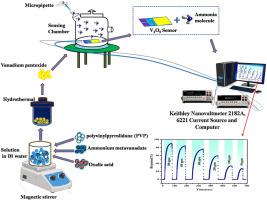Synthesized α-V2O5 nanoparticles and explored their performance as gas sensors in an ammonia atmosphere
IF 2.8
3区 物理与天体物理
Q2 PHYSICS, CONDENSED MATTER
引用次数: 0
Abstract
Metal oxide semiconductor (MOS) chemiresistive sensors are effective for detecting ammonia (NH3), but need high temperatures and have low sensitivity. This work investigates hydrothermally produced α-V2O5 irregular nanodiscs as a possible NH3 sensor for ambient conditions. XRD, UV–vis spectroscopy, FE-SEM, HR-TEM, EDX mapping, and FT-IR were used to identify the material's structure, morphology, composition, and functional groups. The crystallite size (∼27 nm) and band gap (3.4 eV) were determined using the Debye-Scherrer and Tauc equations, respectively, suggesting excellent electronic characteristics. The sensor was tested at 50–500 ppm NH3 concentrations and shown great sensitivity with quick response (22 s) and recovery (17 s). Importantly, performance remained consistent across various relative humidity levels, suggesting resilience to environmental conditions. These findings suggest that α-V2O5 nanodiscs are potentially effective for current time ammonia detection at ambient temperature.

合成α-V2O5纳米粒子,并探索其在氨气氛中作为气体传感器的性能
金属氧化物半导体(MOS)化学电阻传感器是检测氨(NH3)的有效方法,但需要较高的温度和较低的灵敏度。这项工作研究了水热法制备的α-V2O5不规则纳米片作为环境条件下可能的NH3传感器。采用XRD、UV-vis、FE-SEM、HR-TEM、EDX作图、FT-IR等方法对材料的结构、形貌、组成和官能团进行了表征。晶体尺寸(~ 27 nm)和带隙(3.4 eV)分别使用Debye-Scherrer和tac方程确定,表明具有良好的电子特性。该传感器在50-500 ppm NH3浓度下测试,具有高灵敏度,响应速度快(22 s),恢复速度快(17 s)。重要的是,在不同的相对湿度水平下,性能保持一致,表明对环境条件的弹性。研究结果表明,α-V2O5纳米片在常温下的实时氨检测具有潜在的有效性。
本文章由计算机程序翻译,如有差异,请以英文原文为准。
求助全文
约1分钟内获得全文
求助全文
来源期刊

Physica B-condensed Matter
物理-物理:凝聚态物理
CiteScore
4.90
自引率
7.10%
发文量
703
审稿时长
44 days
期刊介绍:
Physica B: Condensed Matter comprises all condensed matter and material physics that involve theoretical, computational and experimental work.
Papers should contain further developments and a proper discussion on the physics of experimental or theoretical results in one of the following areas:
-Magnetism
-Materials physics
-Nanostructures and nanomaterials
-Optics and optical materials
-Quantum materials
-Semiconductors
-Strongly correlated systems
-Superconductivity
-Surfaces and interfaces
 求助内容:
求助内容: 应助结果提醒方式:
应助结果提醒方式:


